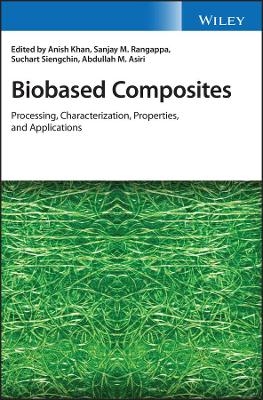
Biobased Composites
John Wiley & Sons Inc (Verlag)
978-1-119-64179-7 (ISBN)
Bio-based Composites: Characterization, Properties, and Applications delivers a comprehensive treatment of all known characterization methods, properties, and industry applications of bio-based composites materials. This unique, one-stop resource covers all major developments in the field from the last decade of research into this environmentally beneficial area.
The internationally recognized editors have selected resources that represent advances in the mechanical, thermal, tribological, and water sorption properties of bio-based composites, and cover new areas of research in physico-chemical analysis, flame retardancy, failure mechanisms, lifecycle assessment, and modeling of bio-based composites.
The low weight, low cost, excellent thermal recyclability, and biodegradability of bio-based composites make them ideal candidates to replace engineered plastic products derived from fossil fuel. This book provides its readers with the knowledge they’ll require to understand a new class of materials increasingly being used in the automotive and packaging industries, aerospace, the military, and construction. It also includes:
An extended discussion of the environmental impact of bio-based composites using a lice cycle methodology
A review of forecasts of natural fiber reinforced polymeric composites and its degradability concerns
An analysis of the physical and mechanical properties of a bio-based composite with sisal powder
A comprehensive treatment of the mechanical, thermal, tribological, and dielectric properties of bio-based composites
A review of processing methods for the manufacture of bio-based composites
Perfect for materials scientists in private industry, government laboratories, or engaged in academic research, Bio-Based Composites will also earn a place in the libraries of industrial and manufacturing engineers who seek a better understanding of the beneficial industrial applications of biocomposites in industries ranging from automobiles to packaging.
Anish Khan, PhD, is Assistant Professor in the Department of Chemistry, Center of Excellence for Advanced Materials Research at King Abdulaziz University in Saudi Arabia. Sanjay M. Rangappa, PhD, is a research scientist at Natural Composites Research Group Lab, Academic Enhancement Department, King Mongkut's University of Technology North Bangkok, Thailand. Suchart Siengchin, D.Eng, is President of King Mongkut's University of Technology North Bangkok, Thailand. Abdullah M. Asiri, PhD, is Director of the Center of Excellence for Advanced Materials Research and Professor in the Department of Chemistry at King Abdulaziz University in Saudi Arabia.
List of Contributors ix
Preface xii
1 Introduction to Biobased Composites 1
Faris M. AL-Oqla
1.1 Introduction 1
1.2 Biodegradable Materials 3
1.3 Polymers in Tissue Engineering 3
1.4 Environmental Realization 5
1.4.1 Green Biomass-based Composites 6
1.4.2 Selection Considerations 6
1.4.2.1 Materials Implementation Requirements 6
1.4.2.2 Material Cost 7
1.5 Biomass Composites Characteristics and Testing 7
1.6 Life-cycle Assessment 9
1.7 Conclusions 10
References 11
2 Processing Methods for Manufacture of Biobased Composites 15
P. Shenbaga Velu, N. J. Vignesh, and N. Rajesh Jesudoss Hynes
2.1 Introduction 15
2.2 Biobased Materials 16
2.3 Processing Methods 17
2.4 Fabrication Techniques of Biobased Composites 19
2.4.1 Solvent Casting and Particulate Leaching 20
2.4.2 Emulsion Freeze Drying 21
2.4.3 Electrospinning 21
2.4.4 Blow Film Extrusion 22
2.4.5 3D Printing 22
2.5 Fillers and Reinforcements Used in the Preparation of Biobased Composites 23
2.5.1 Biobased Fillers/Reinforcements with Non-biobased Polymers 23
2.5.2 Non-biobased Fillers/Reinforcements with Biobased Polymers 23
2.5.3 Biobased Filler/Reinforcement and Biobased Polymer 24
2.6 Conclusion 24
References 25
3 Physicochemical Analysis of Biobased Composites 29
N. J. Vignesh, P. Shenbaga Velu, and N. Rajesh Jesudoss Hynes
3.1 Introduction 29
3.2 Performance of Biocomposites 29
3.2.1 Tensile Properties 30
3.2.2 Flexural Properties 31
3.2.3 Impact Properties 32
3.2.4 Creep 33
3.2.5 Brittleness and Ductility 34
3.2.6 Toughness 34
3.3 Physicochemical Properties 34
3.4 Conclusion 36
References 36
4 Characterization of Biobased Composites 39
Anna Sienkiewicz and Piotr Czub
4.1 Introduction 39
4.2 The Conception of Composites 39
4.3 Classification of Biocomposites 40
4.4 Materials for the Synthesis of Biobased Composites 41
4.4.1 Biopolymers as Matrix of Green Composites 42
4.4.2 Fibers as Natural Reinforcement 43
4.5 Challenges of the Introduction of Natural Fiber 46
References 50
5 Mechanical, Thermal, Tribological, and Dielectric Properties of Biobased Composites 53
T. Senthil Muthu Kumar, K. Senthilkumar, M. Chandrasekar, S. Karthikeyan, Nadir Ayrilmis, N. Rajini, and Suchart Siengchin
5.1 Introduction 53
5.2 Characterization of Biobased Composites 53
5.3 Factors Influencing Various Properties of the Biobased Composites 55
5.3.1 Constituents of Biobased Composites 55
5.3.2 Fabrication Techniques of Biobased Composites 56
5.3.3 Aging and Their Impact on the Composite Properties 59
5.4 Mechanical Properties of Biobased Composites 59
5.5 Thermal Properties of Biobased Composites 61
5.5.1 Thermogravimetric Analysis of Biobased Composites 63
5.5.2 Dynamic Mechanical Analysis of Biobased Composites 64
5.6 Tribological Properties of Biobased Composites 65
5.7 Dielectric Properties of Biobased Composites 67
5.8 Conclusions 69
References 70
6 Flame Retardancy of Biobased Composites 75
N. B. Karthik Babu, T. Ramesh, and Mohit Hemath Kumar
6.1 Introduction 75
6.1.1 Flame Retardants 77
6.1.2 Types of Flame Retardants 78
6.2 Types of Biobased Polymer Composites Used in a Flame-Retardant Application 79
6.3 Role and Effect of Natural Byproducts on the Flame-Retardant Behavior of a Biocomposite 79
6.3.1 Flammability of Biochar Reinforced Biocomposites 79
6.3.2 Commonly Used Agro-wastes to Improve the Flame Retardancy of a Biocomposite 81
6.4 Role and Effect of Biobased Natural Fibers on the Flammability of a Biocomposite 83
6.5 Summary 84
References 84
7 Failure Mechanisms of Biobased Composites 87
Dipen Kumar Rajak, Durgesh D. Pagar, and Catalin I. Pruncu
7.1 Introduction 87
7.1.1 Fiber Reinforcements in Biobased Composites 88
7.1.2 Fiber Failures 88
7.1.2.1 Fiber–Matrix Debonding 88
7.1.2.2 Fiber Pullout 89
7.1.2.3 Tear Type Failure 90
7.1.3 Fiber Pretreatments 90
7.1.3.1 Defibration 90
7.1.3.2 Surface Modification 91
7.1.3.3 Coupling Agent 91
7.2 Matrix Materials for Biobased Composites 91
7.2.1 Matrix Failure 93
7.2.2 Matrix Treatment 93
7.3 Trends in Biobased Composites 93
7.3.1 Wood Plastic Composites 94
7.3.1.1 Failure in WPC 95
7.3.2 Hybrid Combination 96
7.4 Adapted Manufacturing Technologies 97
7.4.1 Injection Molding 97
7.4.2 Liquid Composite Molding 98
7.5 Other Failure Criteria 98
7.6 Conclusion 100
References 100
8 Recent Advances and Technologies of Biobased Composites 107
E. Biswas, S. Hawkins, K. Monroe, T. F. Garrison, and R. L. Quirino
8.1 Introduction 107
8.2 Recent Advances on Biobased Matrices 108
8.2.1 Carbohydrate-Based Matrices 108
8.2.2 Plant Oil-Based Matrices 109
8.2.3 Biobased Polyester Matrices 110
8.2.4 Natural Rubber 111
8.2.5 Collagen 111
8.3 Recent Advances on Biobased Reinforcements 112
8.3.1 Biobased Fiber Reinforcements 112
8.3.2 Wood Biochar-Based Reinforcements 114
8.3.3 Biobased Nanocomposite Reinforcements 114
8.3.3.1 Cellulose Nanocomposites 114
8.3.3.2 Other Nanocomposites 115
8.4 Recent Advances on Biobased Composite Processing 115
8.4.1 Extrusion and Injection Molding Techniques 116
8.4.2 Wet Lay-Up Techniques 116
8.4.3 3D Printing of Biobased Composites 116
8.5 Conclusion 117
References 118
9 Biocomposites for Energy Storage 123
M. Ramesh, J. Maniraj, and L. Rajesh Kumar
9.1 Introduction 123
9.2 Fundamental Concepts 124
9.2.1 Background 124
9.3 Selection Parameters for Biocomposites 126
9.3.1 Host Response and Biocompatibility 126
9.3.2 Biofunctionality 126
9.3.3 Functional Tissue Structure and Pathobiology 126
9.3.4 Toxicology 127
9.3.5 Design and Manufacturability 127
9.3.6 Mechanical Properties 127
9.3.7 Corrosion Resistance 127
9.3.8 Wear and Fatigue Resistance 128
9.4 Biocomposites for Energy Storage 128
9.5 Bioinspired Composite Materials 130
9.6 Bioinspired Composites for Energy Storage 131
9.7 Enzyme-Based Materials 133
9.8 Biosensing/Bioimaging Applications 133
9.9 Conclusion 135
References 136
10 Analysis of the Physical and Mechanical Properties of A Biobased Composite with Sisal Powder 143
Kátia Moreira, Thiago Santos, Caroliny Santos, Rubens Fonseca, Moises Melo, and Marcos Aquino
10.1 Introduction 143
10.2 Biobased Composites 143
10.3 Polyester Matrix Composites 143
10.4 Manufacture of Composites 144
10.5 Physical–Mechanical Tests 144
10.6 Analysis of Physical and Mechanical Properties 146
10.7 Conclusions 149
Acknowledgments 150
References 150
11 Physico-Mechanical Properties of Biobased Composites 153
A. V. Kiruthika
11.1 Introduction 153
11.1.1 Biobased Fibers 155
11.1.2 Biobased Matrices 155
11.2 Physico-Mechanical Property of the Biobased Composites 155
11.2.1 Density of Biobased Composites 155
11.2.2 Mechanical Properties of Biobased Composites 157
11.3 Applications of Biobased Composites 163
11.4 Conclusions 163
References 164
12 Synthesis and Utilization of Biodegradable Polymers 167
Lalit Ranakoti, Brijesh Gangil, Pawan Kumar Rakesh, and Nikita Agrawal
12.1 Introduction 167
12.2 Synthesis Techniques of Biodegradable Polymers 167
12.2.1 By Modifying Natural Polymers 167
12.2.2 Polymers Synthesized by Chemicals 169
12.2.3 Polymers Synthesized by Microorganisms 169
12.2.4 Synthesis by Enzymes 169
12.2.5 Synthesis by Chemo-Enzymes 169
12.3 Biodegradable Polymers and Their Synthesis 170
12.3.1 Starch 170
12.3.2 Polylactic Acid 170
12.3.3 Polycaprolactone 170
12.3.4 Polyhydroxyalkanoates/Polyhydroxybutyrate 170
12.3.5 Starch–Polyolefin Blends 171
12.3.6 Starch–Polyester Blends 171
12.3.7 Starch–PLA Blends 171
12.4 Applications of Biopolymers in Industries 171
12.5 Conclusion 172
References 172
13 Forecasts of Natural Fiber Reinforced Polymeric Composites and Its Degradability Concerns – A Review 175
D. Divya, S. Indran, M. R. Sanjay, and Suchart Siengchin
13.1 Introduction 175
13.2 Recent Trends of Natural Fiber Production from Plants 176
13.3 Magnitude of Natural Fibers at this Juncture 179
13.4 Constraints and Competence of Natural Fibers 185
13.5 Degradability of Polymeric Natural Fiber Composites 187
13.6 Marine Application of Natural Fiber Composites and Its Degradation 189
13.7 Conclusion 190
Acknowledgments 190
References 190
14 Biofibers and Biopolymers for Biocomposites – in the Eyes of Spectroscopy 197
Madhu Yadav, Jamal Akhter Siddique, Aftab Aslam Parwaz Khan, Anish Khan, and Abdullah M. Asiri
14.1 Introduction 197
14.1.1 Polylactic Acid 198
14.1.2 Polyhydroxyalkanoates 199
14.1.3 Polycaprolactone 199
14.2 Characterization 199
14.2.1 Scanning Electron Microscopy 200
14.2.1.1 Morphological Inspection by SEM 200
14.2.1.2 Degree of Adhesion by SEM 201
14.2.1.3 Water Absorption of Composites by SEM 202
14.2.2 Optical Microscopy 202
14.2.3 Atomic Force Microscopy 203
14.2.4 Transmission Electron Microscopy 203
14.2.5 Spectroscopic Techniques 203
14.2.5.1 NMR Analysis 203
14.2.5.2 Infrared Spectroscopy (IR) 205
14.2.5.3 Acoustic Emission Spectrometry 207
14.3 Conclusions 208
References 208
15 Environmental Impact Study on Biobased Composites Using Lifecycle Methodology 213
P. Ramesh, H. Mohit, and V. Arul Mozhi Selvan
15.1 Introduction 213
15.2 Lifecycle Assessment 214
15.2.1 Goal and Scope 214
15.2.2 Inventory Data 214
15.2.3 Impact Assessment 215
15.2.4 Interpretation 215
15.3 Simplified Case Study 215
15.4 Goal and Scope 215
15.5 System Boundary 215
15.6 Inventory Analysis 215
15.7 Impact Assessment 217
15.8 Results 217
15.8.1 Normalization 218
15.9 Conclusion 221
References 221
Index 223
| Erscheinungsdatum | 20.04.2021 |
|---|---|
| Verlagsort | New York |
| Sprache | englisch |
| Maße | 10 x 10 mm |
| Gewicht | 454 g |
| Themenwelt | Technik ► Maschinenbau |
| ISBN-10 | 1-119-64179-9 / 1119641799 |
| ISBN-13 | 978-1-119-64179-7 / 9781119641797 |
| Zustand | Neuware |
| Informationen gemäß Produktsicherheitsverordnung (GPSR) | |
| Haben Sie eine Frage zum Produkt? |
aus dem Bereich


